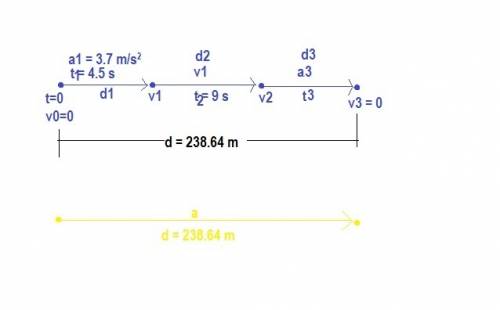
Physics, 13.10.2019 11:00 ethangorrell67
Two cars start from rest at a red stop light. when the light turns green, both cars accelerate forward. the blue car accelerates uniformly at abrate of 3.7m/s^2 for 4.5 seconds. it then continues at a constant speed for 9 seconds, before applying brakes such that the car's speed decreases uniformly coming to rest 238.64 meters from where it started. the yellow car accelerates uniformly for the entire distance, finally catching the blue car just as the blue car comes to a stop
1. how fast is the blue car going 2.2 seconds after it starts?
2. how fast is the blue car going 11.3 seconds after it starts?
3. how far does the blue car travel before its brakes are appliedbto slow down
4. what is the acceleration of the blue car once the brakes are applied
5. what is the total time the blue car is moving?
6. what is the acceleration of the yellow car?

Answers: 3


Another question on Physics

Physics, 22.06.2019 10:30
Light from a sodium lamp passes through a diffraction grating that has 1000 slits per millimeter. the interference pattern is viewed on a screen 1.000 m behind the grating. the first (m = 1) two bright yellow fringes that are visible are 0.7288 m and 0.7300 m from the central maximum. what are the wavelengths of these two fringes?
Answers: 2

Physics, 22.06.2019 15:20
A20 cm long spring is attached to a wall. the spring stretches to a length of 22 cm when you pull on it with a force of 100 n. what is the spring constant
Answers: 3

Physics, 22.06.2019 17:40
Emmy kicks a soccer ball up at an angle of 45° over a level field. she watches the ball's trajectory and notices that it lands, two seconds after being kicked, about 20 m away to the north. assume that air resistance is negligible, and plot the horizontal and vertical components of the ball's velocity as a function of time. consider only the time that the ball is in the air, after being kicked but before landing. take "north" and "up" as the positive ‑ and ‑directions, respectively, and use ≈10 m/s2 for the downward acceleration due to gravity.
Answers: 2

Physics, 23.06.2019 01:00
Formulating a hypothesis: part i since the investigative question has two variables, you need to focus on each one separately. thinking only about the first part of the question, mass, what might be a hypothesis that would illustrate the relationship between mass and kinetic energy? use the format of " because when writing your hypothesis
Answers: 1
You know the right answer?
Two cars start from rest at a red stop light. when the light turns green, both cars accelerate forwa...
Questions


Social Studies, 24.05.2021 01:00

Social Studies, 24.05.2021 01:00

Mathematics, 24.05.2021 01:00


Mathematics, 24.05.2021 01:00

History, 24.05.2021 01:00

Spanish, 24.05.2021 01:00

Mathematics, 24.05.2021 01:00





Mathematics, 24.05.2021 01:00

Computers and Technology, 24.05.2021 01:00

Mathematics, 24.05.2021 01:00

Social Studies, 24.05.2021 01:00

Mathematics, 24.05.2021 01:00

Mathematics, 24.05.2021 01:00

History, 24.05.2021 01:00




